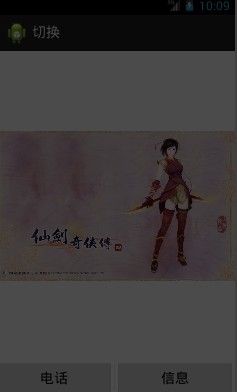Android应用的tab切换效果
在进行Android开发时经常配到,要使用Tab的情况,遇到不同的项目老大时,没人都还有自己的风格。下面续写一下我总结的自己觉得要注意的几种方式。
第一:使用Tabhost+Fragment实现tab切换,并通过Fragment转载xml并绑定监听事件可以实现响应xml的效果。
首先mian.xml文件
<TabHost xmlns:android="http://schemas.android.com/apk/res/android" android:id="@android:id/tabhost" android:layout_width="fill_parent" android:layout_height="fill_parent" > <LinearLayout android:id="@+id/layout" android:layout_width="fill_parent" android:layout_height="wrap_content" android:orientation="vertical" > <FrameLayout android:id="@android:id/tabcontent" android:layout_width="fill_parent" android:layout_height="wrap_content" android:layout_weight="1" > <FrameLayout android:id="@+id/fragment_phone" android:layout_width="fill_parent" android:layout_height="wrap_content" > </FrameLayout> <FrameLayout android:id="@+id/fragment_mess" android:layout_width="fill_parent" android:layout_height="wrap_content" > </FrameLayout> </FrameLayout> <TabWidget android:id="@android:id/tabs" android:layout_width="fill_parent" android:layout_height="wrap_content" android:layout_weight="0" android:tag="tabs" > </TabWidget> </LinearLayout> </TabHost>
下面通过Fragment转载xml来表示要切换的页面 这里xml中仅仅放一个图片
mess.xml
<?xml version="1.0" encoding="utf-8"?> <LinearLayout xmlns:android="http://schemas.android.com/apk/res/android" android:layout_width="match_parent" android:layout_height="match_parent" android:orientation="vertical" > <ImageView android:id="@+id/show" android:layout_width="fill_parent" android:layout_height="fill_parent" android:src="@drawable/xianjian01" /> </LinearLayout>
phone.xml
<?xml version="1.0" encoding="utf-8"?> <LinearLayout xmlns:android="http://schemas.android.com/apk/res/android" android:layout_width="match_parent" android:layout_height="match_parent" android:orientation="vertical" > <ImageView android:id="@+id/show" android:layout_width="fill_parent" android:layout_height="fill_parent" android:src="@drawable/xianjian02" /> </LinearLayout>
public class MessFragment extends Fragment { @Override public void onCreate(Bundle savedInstanceState) { // TODO Auto-generated method stub super.onCreate(savedInstanceState); } @Override public View onCreateView(LayoutInflater inflater, ViewGroup container, Bundle savedInstanceState) { // TODO Auto-generated method stub return inflater.inflate(R.layout.mess, container,false); } }public class PhoneFragment extends Fragment { @SuppressLint("NewApi") @Override public void onCreate(Bundle savedInstanceState) { // TODO Auto-generated method stub super.onCreate(savedInstanceState); } @Override public View onCreateView(LayoutInflater inflater, ViewGroup container, Bundle savedInstanceState) { // TODO Auto-generated method stub return inflater.inflate(R.layout.phone, container,false); } }public class MainActivity extends android.support.v4.app.FragmentActivity implements OnTabChangeListener{ private String [] titles= {"电话","信息"}; private int [] tabIDs = {R.id.fragment_phone,R.id.fragment_mess}; private TabHost mhost; private Fragment frag=null; private int convertID; private FragmentManager manager = getFragmentManager(); @Override protected void onCreate(Bundle savedInstanceState) { super.onCreate(savedInstanceState); setContentView(R.layout.activity_main); initView(); } private void initView(){ mhost = (TabHost)findViewById(android.R.id.tabhost); mhost.setup(); for (int i = 0; i < tabIDs.length; i++) { Button button = new Button(this); button.setText(titles[i]); mhost.addTab(mhost.newTabSpec(titles[i]).setIndicator(button).setContent(tabIDs[i])); } mhost.setOnTabChangedListener(this); frag = new PhoneFragment(); convertID = R.id.fragment_phone; FragmentTransaction trans = manager.beginTransaction(); trans.replace(convertID, frag, titles[0]); trans.commit(); } @SuppressLint("NewApi") @Override public void onTabChanged(String tag) { // TODO Auto-generated method stub if(tag.equals(titles[0])){ frag = new PhoneFragment(); convertID = R.id.fragment_phone; }else if (tag.equals(titles[1])) { frag = new MessFragment(); convertID = R.id.fragment_mess; } if(tag==null){ return; } if (manager.findFragmentByTag(tag) == null) { FragmentTransaction trans = manager.beginTransaction(); trans.replace(convertID, frag, tag); trans.commit(); } } }
当然你如果要实现复杂的界面,只需要在onCreateView 中得到xml 中的控件,,并为其制定事件监听即可
这样就可以实现切换了效果如下:
如果要实现下面Tab的边效果 只要制定一个xml配置文件然后制定那个图片选中或者那种背景颜色即可;第二种机会讲到
第二;实现微博那样的菜单效果:已经有人做了很好的总结,就不写了
http://blog.csdn.net/yangyu20121224/article/details/9016223
